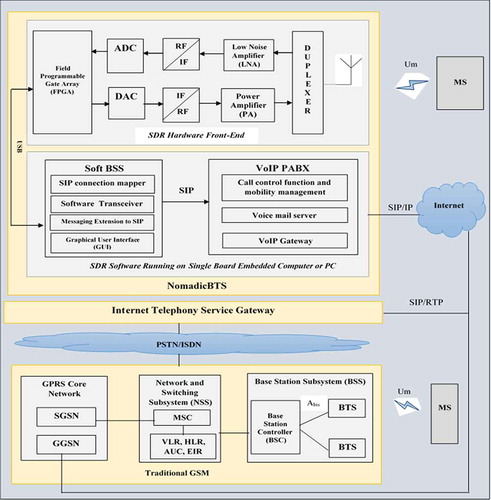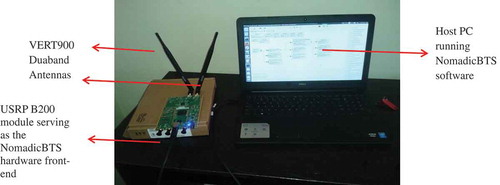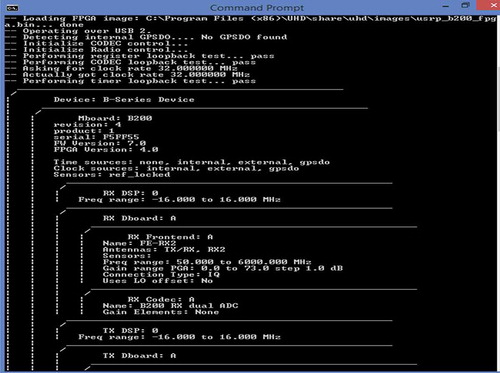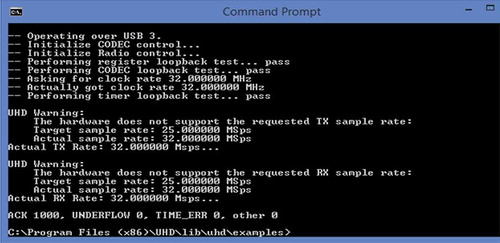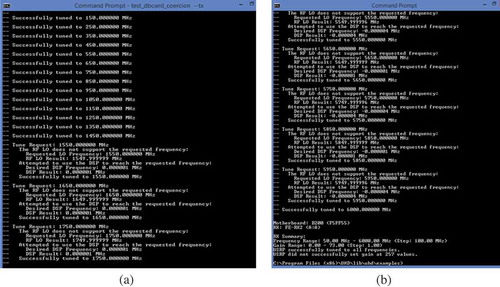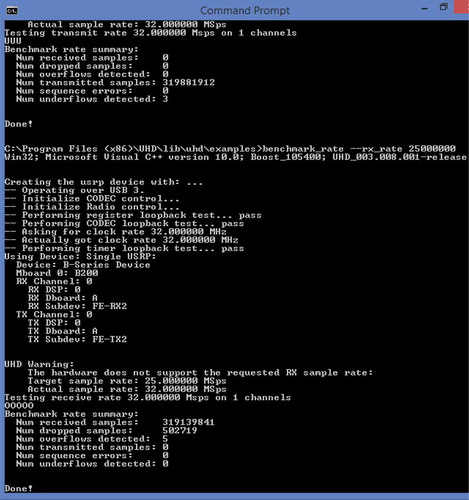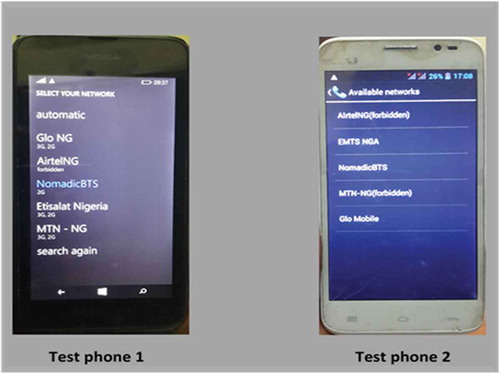 ?Mathematical formulae have been encoded as MathML and are displayed in this HTML version using MathJax in order to improve their display. Uncheck the box to turn MathJax off. This feature requires Javascript. Click on a formula to zoom.
?Mathematical formulae have been encoded as MathML and are displayed in this HTML version using MathJax in order to improve their display. Uncheck the box to turn MathJax off. This feature requires Javascript. Click on a formula to zoom.Abstract
Utilization of software-defined radio (SDR) and open-source technologies in the next evolution of cellular communication networks may significantly reduce the capital expenditure (CAPEX) and operating expenditure (OPEX) of mobile network operators in emerging economies. In this paper, a novel cellular communication architecture named NomadicBTS was proposed, designed, and prototyped based on SDR paradigm to achieve an efficient, dynamic, and cost-effective wireless communication. The architecture comprises of hardware front-end and software that are compatible with general-purpose processor. Open-source technologies were adopted to implement a proof-of-concept architype of the architecture. A prototype femtocell (of approximately 7.54-m cell radius) was set up and two different commercially available smart phones were used to scan, detect, and measure the strength and quality of radio signals that were transmitted by the NomadicBTS prototype. Experimentation results showed that the network signal is visible to the smart phones, and its strength and quality are sufficient for good transmission and reception of Short Messaging Services (SMS). Unlike the conventional cellular networks which are capital-intensive, the results obtained in this study provide a basis to deploy low-cost cellular communication networks for the underserved areas in developing countries.
PUBLIC INTEREST STATEMENT
With the conventional cellular communication networks, the cost of deploying and running mobile applications and services in most developing countries is relatively high and unaffordable. However, Software-defined radio (SDR) architecture offers an effective and efficient platform for mobile network operators to achieve backward compatibility of legacy digital mobile standards (2G/2.5G) with state-of-the-art (3G/4G) and emerging standards (5G) at a very low capital expenditure (CAPEX) and operating expenditure (OPEX). In this work, open-source technologies were adopted to implement a proof-of-concept prototype of the SDR architecture named NomadicBTS. The results of the tests conducted on the prototype proved that the architecture can be leveraged on to develop and deploy low-cost cellular communication networks for the underserved areas in emerging economies.
1. Introduction
The evolution of wireless communication technologies is rapid and the number of mobile devices, applications, and services is growing in an unprecedented dimension (Andrews et al., Citation2014; Boccardi, Heath, Lozano, Marzetta, & Popovski, Citation2014; Kumar, Liu, & Sengupta, Citation2010; Pedreno-Manresa, Khodashenas, Siddiqui, & Pavon-Marino, Citation2018). The evolution of wireless cellular communication started with the first-generation (1G) cellular technology. The analogue system utilizes frequency division multiplexing (FDM) and circuit switching for its operations. However, the power consumed by the system is large while the quality of calls is low (del Peral-Rosado, Raulefs, López-Salcedo, & Seco-Granados, Citation2017). The introduction of the Global System for Mobile communications (GSM) standards marked the birth of the second-generation (2G) technology. GSM technology adopted a simplified encryption to overcome the security challenge of eavesdropping in 1G cellular systems (Kune, Koelndorfer, Hopper, & Kim, Citation2012). Furthermore, the third-generation (3G) technology improved the voice quality with better Quality of Service (QoS) delivered at a data rate of 2 Mbps (Honkasalo, Pehkonen, NieMi, & Leino, Citation2002). Continuous demand for enhanced data rate by mobile users led to the development of the fourth-generation (4G) networks which feature higher data rate of 50–100 Mbps and Internet Protocol (IP) capability (Akyildiz, Gutierrez-Estevez, & Reyes, Citation2010).
The introduction of the fifth-generation (5G) mobile networks has become irrefutably essential in meeting the global mobile data traffic of the future. Also, backward compatibility of 5G networks becomes highly imperative, given the fact that GSM has been acclaimed as the most successful wireless standard in the world with an extensive coverage of above 90% of the global population (Gerstacker et al., Citation2011). In order to achieve backward compatibility of legacy digital mobile standards (2G/2.5G) with state-of-the-art (3G/4G) and emerging standards (5G) at a very low cost, the software-defined radio (SDR) architecture becomes very handy.
SDR is a modern radio engineering approach in which components that were hitherto implemented in hardware are now implemented using software on an embedded platform such as Field Programmable Gate Array (FPGA) or Personal Computer (PC) (Jondral, Citation2005). With SDR, it is now possible to have malleable reconfiguration of wireless systems with attributes such as efficient spectrum access, rapid development, inexpensive implementation, easy upgradeability, high flexibility, enhanced Radio Frequency (RF) signal analysis and inter-operability among heterogeneous wireless standards (Thompson, Clem, Renninger, & Loos, Citation2012). Modern hardware and software platforms have been developed for rapid prototyping based on the SDR architecture. A leading example of such platforms for open-source software development is the GNU Radio (Reyes, Subramaniam, Kaabouch, & Hu, Citation2016). Different versions of Universal Software Radio Peripheral (USRP) are major hardware platforms for SDR (Akhtyamov et al., Citation2016). With the combination of these evolving technologies, complete SDR implementations of different wireless standards from 2G to 5G can be achieved. However in the past, it was mandatory to carry out hardware design of separate custom-built radios for different standards, which could be large and expensive. Nowadays, a single versatile SDR hardware can be modified to carry out multiple functions depending on the code it is running at a comparatively low cost.
Several efforts by researchers have led to the development of wireless systems based on the SDR paradigm. The Speakeasy Multiband Multimode Radio (MBMMR) appeared in the mid-1990s. The military radio systems incorporated software for controlling most of the signal processing in digital format. This radio system made it possible for a single set of hardware to work seamlessly on different frequencies and communications protocols. Speakeasy provided several benefits to the military environment where communication to different command levels and at different ranges may require different RF bands, modulation schemes, vocoders, and encryption algorithms (Lackey & Upmal, Citation1995). Maheshwarappa and Bridges (Citation2014) proposed an SDR architecture that incorporated a combination of FPGA and field programmable RF transceiver for back-end and front-end signal processing thereby facilitating the reception of multiple satellites with one user equipment.
In this paper, a novel cellular communication architecture, known as Nomadic Base Transceiver Station (NomadicBTS), was proposed, designed, and prototyped based on SDR paradigm to achieve an efficient, dynamic, and cost-effective wireless communication. The architecture comprises of hardware front-end and software that are compatible with general-purpose processor. Open-source technologies were adopted to implement a proof-of-concept architype of the architecture. The rest of the paper is organized as follows. Section 2 presents the materials and methods. Section 3 presents the results and discussion. Finally, Section 4 concludes the paper.
2. Materials and methods
2.1. NomadicBTS architecture
Figure shows the architecture of the NomadicBTS and its interconnections with the traditional GSM architecture as well as the Public Switch Telephone Network (PSTN) or Integrated Services Digital Network (ISDN). The NomadicBTS comprises of two major submodules namely: SDR hardware front-end and SDR software back-end running on a single-board embedded computer or PC.
The SDR hardware front-end comprises of the receiver and the transmitter stages for RF signal processing. At the receiver stage, the signal at the receiving antenna is forwarded to the Low Noise Amplifier (LNA) via a duplexer. The RF signal is translated to an Intermediate Frequency (IF), which is then digitized by the Analog-to-Digital Converter (ADC). Decoding, data rate conversion, timing, and various access schemes are carried out by the FPGA. At the transmitter stage, the digital signals are converted to analogue waveforms by the Digital-to-Analogue Converter (DAC), up-converted from IF to RF, amplified through the Power Amplifier (PA), and routed via the duplexer to the antenna. The hardware front-end of the SDR can be realized with any of the commercially available options which include HackRF, BladeRF, Ettus USRP, Matchstiq, and ZeptoSDR (Maheshwarappa & Bridges, Citation2014). In this work, the Ettus USRP B200 was used to realize the SDR front-end because of its admirable features (Ettus, Citation2008).
The SDR software back-end comprises of the Soft Base Station Subsystem (SoftBSS) and the Voice over Internet Protocol Private Automatic Branch Exchange (VoIP PABX) software running on a single-board embedded computer or PC with an Operating System (OS). The SoftBSS provides the necessary interconnection between the SDR front-end hardware and the VoIP PABX. SoftBSS implements a software transceiver which performs functions such as frequency tuning, Gaussian Minimum Shift Keying (GMSK) modulation and demodulation, clock synchronization, control command transaction as well as transmission of receive and transmit bursts. It also implements the Session Initiation Protocol (SIP) mapping functions in order to establish SIP connections for processing by the VoIP PABX. For instance, the International Mobile Subscriber Identity (IMSI) stored on the Subscriber Identity Module (SIM) card of a Mobile Station (MS), which is the end-user phone, is presented to the VoIP PABX as an SIP client. The location of the MS is mapped to SIP registration, call connection is mapped to SIP transactions, while Short Message Services (SMS) function is realized through instant messaging extension to SIP (Apvrille, Citation2011). The SoftBSS, as shown in Figure , also contains a Graphical User Interface (GUI) to provide access for configuring the NomadicBTS by technical administrator in a user-friendly manner. As a proof of concept, the SoftBSS was realized, in this present study, using a combination of open-source technologies such as Ubuntu Linux, OpenBTS and GNU Radio (Burgess & Samra, Citation2008; Reyes et al., Citation2016).
As illustrated in Figure , the VoIP PABX carries out functions like call control and mobility management. It also implements voice mail server and VoIP gateway. The VoIP gateway provides interconnection to the PSTN and to the traditional GSM network using SIP and Real-time Transport Protocol (RTP) via an Internet Telephony Service Gateway (ITSG). In this study, the VoIP PABX section of the NomadicBTS architecture was realized using Asterisk, which is a leading software VoIP PABX (Imran, Qadeer, & Khan, Citation2009).
2.2. NomadicBTS prototype setup
The NomadicBTS experimental prototype cell setup is shown in Figure . At this stage of the study, the prototype cell was not linked with the traditional GSM network. The USRP B200 adopted for the SDR hardware front-end covers 50 MHz to 6 GHz frequency range, which falls within the microwave portion of the RF spectrum as shown in Figure . Apparently, the USRP B200 can adequately operate within the GSM 900 and GSM 1800 bands. The device provides interfaces for two dual-band VERT900 antennas with 824–960 MHz and 1710–1990 MHz frequency bands.
Figure 3. Electromagnetic spectrum (Stewart, Barlee, Atkinson, & Crockett, Citation2015).
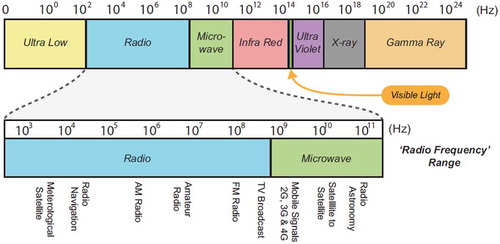
The technical specifications of the device as related to this study are presented in Table . The device can stream up to 56 MHz of instantaneous data bandwidth over a high-speed USB 3.0 bus operating at 4.8 Gbps full duplex to the host PC. The RF/IF signal processing tasks on the device are carried out by the AD9364 Radio Frequency Integrated Circuit (RFIC), which is a direct conversion transceiver along with the Spartan 6 FGPA. The host PC shown in Figure runs the SDR software back-end of the NomadicBTS architecture. It contains an Intel Core i5-3210M, 8.00 GB Random Access Memory (RAM), and operates at Central Processing Unit (CPU) speed of 2.50 GHz. This PC contains both the Microsoft Windows 8 and the open-source Ubuntu 16.04 LTS OSs. The USRP Hardware Driver (UHD) running on the Windows 8 OS was used in testing the adequacy of the USRP B200 device for this study while the Linux OS serves as the development and deployment platform.
Table 1. USRP parameters (Ettus, Citation2008)
3. Results and discussions
In this section, the results obtained from the various tests carried out on the USRP B200 hardware module are presented. The module was tuned to the licensed GSM 900 and GSM 1800 bands in Nigeria in order to verify its capability for real-time signal transmission and reception. The radius of the prototype cell was computed using the measured signal strengths. Furthermore, the connections of smart GSM phones (test phones) to the prototype cell were verified and the intercommunication between the phones is reported based on SMS transmission and reception capabilities.
3.1. USRP B200 testing
After installing the UHD software on the host PC in Windows 8 OS, different tests were carried out on the USRP B200 module. Firstly, to ensure that the device is recognized by the host PC and obtain the default configurations of the device, appropriate UHD commands were invoked. The results presented in Figure show that the host PC recognized the module, the serial number of F5FF55, the receiver and transmitter frequency range of 50 MHz to 6 GHz, and host of other parameters.
Next, latency, coercion and benchmark tests were carried out. Latency test receives a packet at time t and tries to send a packet at time t + rtt, where rtt is the round trip time from device to the host PC and back to the device. Figure shows the outcome of the latency test on the USRP B200 module. All the packets sent were acknowledged (ACK = 1000) and the underflows as well as the errors were both equal to zero. These parameters are indications of good interface latency of the USRP module.
The coercion test was carried out using appropriate UHD command to ensure that the USRP B200 daughter boards can successfully tune to all specified frequencies and gains. The outputs of the test are shown in Figure . These outputs indicate that both the transmitter (Tx) and the receiver (Rx) sections of the device can operate within the specified frequency range of 50 MHz to 6 GHz. Thus, the device is considered suitable for both GSM 900 and GSM 1800, which operate at 900 MHz and 1.8 GHz, respectively.
Furthermore, benchmark test, which involves the use of appropriate UHD command to obtain the throughput capability of the host PC with the USRP B200 device, was carried out. The result of the test is shown in Figure . The output comprises of the number of sent frames, overflows, dropped frames, received frames, sequence errors, and underflows detected. The result showed that the “transmit” and the “receive” components of the device are working optimally. Therefore based on the foregoing tests, the USRP B200 is considered satisfactorily adequate for implementing the hardware front-end of the NomadicBTS architecture in Figure .
3.2. GSM spectrum view
The USRPB200 device was further validated in this study by investigating its signal reception capability from neighbouring licensed base stations. This is to ensure that the module can successfully process real-time RF signals. A spectrum browser flow graph in GNU Radio Companion (GRC) was used to accomplish this task on an Ubuntu Linux 16.04LTS OS. This investigation was conducted at the downlink frequencies. In Nigeria, the downlink frequency ranges of the licensed operators by the Nigeria Communication Commission (NCC) in the 900 bands as at the time of this study are as follows: Etisalat (935–940 MHz), MTel (940–945 MHz), Globacom (945–950 MHz), MTN (950–955 MHz), and Airtel (955–960 MHz). Figure shows the plot of the amplitude against the frequency ranges for (a) 936–944 MHz and (b) 942–950 MHz. It can be observed in Figure ) that the band covering 936–940 MHz, which correspond to the Etisalat licensed region, is active with traffic. However, band of spectrum in the range 940–944 MHz, which corresponds to the MTel-licensed region, is inactive (see Figure ) and ()). In Figure ), the band 945–948 MHz, which corresponds to the Globacom spectrum, is also very active.
Figure 8. Spectrum of received signal by USRPB200 for the frequency ranges: (a) 936–944 MHz and (b) 942–950 MHz.
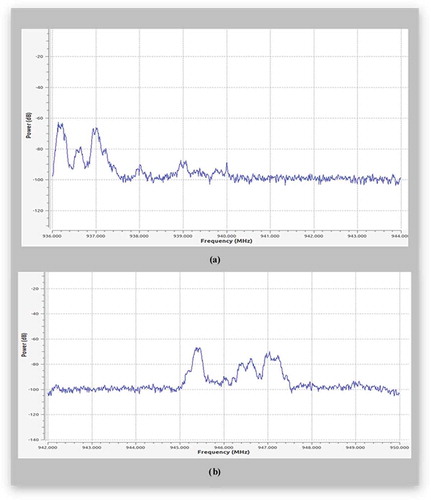
Figure shows the spectrum of (a) 947–955 MHz and (b) 952–960 MHz bands obtained from the spectrum browser. In Figure ), the region from 950 to 955 MHz, which is the MTN band, is conspicuously active with traffic. Similarly, the region from 955 to 960 MHz, which is the Airtel band, is also active with traffic. These results imply that out of the five licensed operators in the GSM 900 band in Nigeria, only MTel does not have installed BTS in the proximity of the laboratory where this study was carried out. In addition, the results provide a basis to utilize the USRP B200 along with the PC running the SDR software for a prototype NomadicBTS cell site in this study.
3.3. Signal strength measurement and determination of cell radius
The signal strength of the NomadicBTS prototype cell that was set up in a laboratory was measured using the Network Signal Info Pro tool. This software is a signal strength measurement mobile app. The prototype cell was configured to operate at the 900 MHz band using an Absolute Radio Frequency Channel Number (ARFCN) of 1. The signal strength measurement was used to determine how seamless the mobile device can connect to the NomadicBTS prototype cell in the context of this study. Signal strength was represented with Received Signal Strength Indicator (RSSI) measured in dBm in Network Signal Info Pro. Arbitrary Strength Unit (ASU)—an integer value that is proportional to RSSI was also used to present the signal strength alongside the RSSI by Network Signal Info Pro. The interpretation of the ASU values is shown in Table .
Table 2. Description of ASU integer values
The signal strength obtained at an approximate distance of 30 cm from one of the test mobile phones (on which the Network Signal Info Pro app was installed) to the prototype cell in this study is shown in Figure . The signal strength is −57 dBm with 28 asu. Based on the description of ASU in Table , this is a perfect signal strength. Other relevant descriptions of the prototype cell are shown in Figure .
Figure 10. NomadicBTS signal measurement at close proximity (30 cm) with one of the test mobile phones using Network Signal Info Pro mobile app.
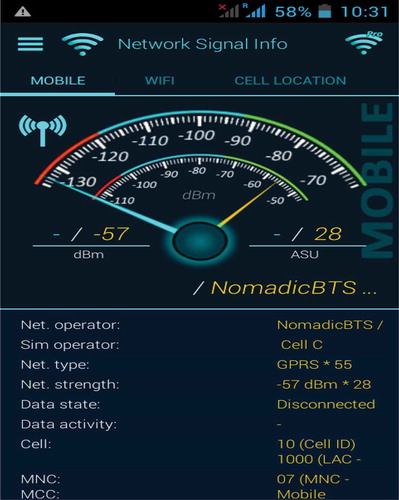
Also, the signal strengths were measured at different locations within the vicinity of the prototype cell. The locations where the measurements were taken are indicated on the Google map shown in Figure . The prototype cell for this study was setup at the South-Eastern end of the Electrical and Information Engineering (EIE) building at Covenant University, Ota, Nigeria (latitude 6.6718°N, longitude 3.1581°E). The signal strengths obtained are shown in Figure . At the car park between the Civil Engineering and EIE buildings, the received signal strength (−101 dBm, 6 asu) was found to be normal while at the reception lobby of the EIE building, the received signal strength (−103 dBm, 5 asu) was found to be weak. However, the other locations where signals were measured presents good signal strengths as shown in Figure .
Figure 11. Google earth view of the NomadicBTS prototype cell location and the measured signal strengths.
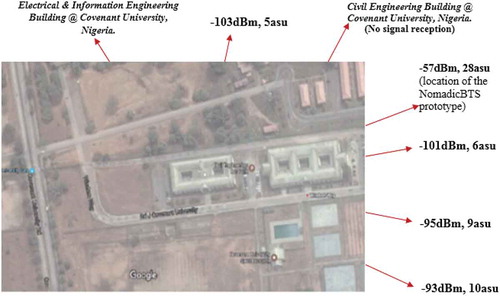
The radius of the prototype cell is computed as follows (Frattasi & Della Rosa, Citation2017):
where Rc is the cell radius, r is the distance from the test mobile phone to the prototype cell site, and dBm represents the measured signal strength at r. Using the signal strength at approximately 30 cm from the prototype cell, which is −57 dBm, we have
Therefore, the approximate cell radius of our prototype cell is 7.54 m, which can be described as an approximate femtocell with potential for cellular communications within homes or offices (Elleithy & Rao, Citation2011).
3.4. Testbed for mobile equipment connection to the prototype cell and SMS communication
The testbed for the NomadicBTS prototype cell for this study was set up within our laboratory and it has a radius of 7.54 m. This is a femtocell as established, and consequently, there is a negligible interference with active commercial traffic. As shown in Figure , the two test phones used for this study are Window’s phone NOKIA Lumia 530 and Android phone BLU DASH 5.0. The two phones were able to detect all the licensed operators within the vicinity of the study location in agreement with the detected traffics. In addition, the test phones were also able to successfully establish connection to the prototype cell whose network ID is NomadicBTS as shown in Figure .
The prototype cell was further tested by sending an SMS text with the BLU DASH as the sender with a subscriber ID of 0000655073322311152 and the NOKIA Lumia phone as the recipient with an ID 123456789 . These subscriber IDs were configured on the NomadicBTS prototype cell. The successfully sent and received text messages are shown in Figure . The current work provides a proof of concept and real-time implementation of the simulation work reported in (Adetiba et al., Citation2011). In codicil, a prior study which prototyped a cellular network for rural areas using open-source technologies corroborates the feasibility of our approach as a good alternative to the orthodox cellular networks (Anthony, Gabriel, & Shao, Citation2016). Enhancement in signal propagation and coverage for the NomadicBTS prototype cell will, however, be achieved in the future through path loss modelling (Matthews, Osuoyah, Popoola, Adetiba, & Atayero, Citation2017; Popoola, Adetiba, Atayero, Faruk, & Calafate, Citation2018; Popoola et al., Citation2017; Surajudeen-Bakinde et al., Citation2018).
The possible risk associated with the use of the proposed system is the health implications of electromagnetic radiations. Meanwhile, the operations of NomadicBTS are strictly limited to radio frequencies and the spectrum band is categorized as non-ionizing electromagnetic radiation (Calvente, Fernandez, Villalba, Olea, & Nunez, Citation2010; Repacholi, Citation1998). The health effect of the energy produced by the non-ionizing electromagnetic radiation on human body is below what is obtainable at the atomic level. The design and implementation of NomadicBTS clearly conform to the guidelines provided by International Commission on Non-Ionizing Radiation Protection (ICNIRP) (Rüdiger et al., Citation2014).
4. Conclusion
The architecture of NomadicBTS, which is an SDR-based cellular system and the prototype cell developed based on the architecture have been presented in this paper. We have been able to demonstrate the possibilities of evolving a cost effective cellular communication system with the results and the open-source technologies adopted for this work. Different tests were carried out to and satisfactory results were obtained to justify the choice of USRP B200 for implementing the hardware front-end of the NomadicBTS. In the future, we hope to incorporate other features such as voice and data communication, interconnection among multiple NomadicBTS, connection with existing GSM networks, surveys for path loss propagation modelling and implementation of the architecture for 3G/45/5G mobile technologies.
Acknowledgements
The development of the prototype based on the NomadicBTS architecture is funded through a research grant awarded to EA, VOM and SNJ by the Nigeria Communications Commission (NCC) while the publication of the study is funded by the Covenant University Centre for Research, Innovation and Discovery (CUCRID).
Additional information
Funding
Notes on contributors
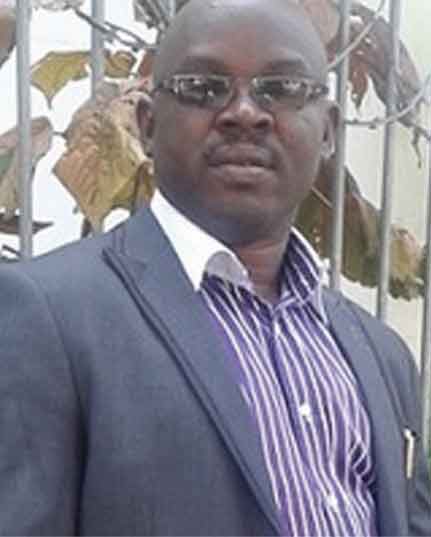
Emmanuel Adetiba
Emmanuel Adetiba obtained a PhD degree in Information and Communication Engineering at Covenant University, Ota, Nigeria in January 2014. He is a registered engineer (REngr.) with the Council for the Regulation of Engineering in Nigeria and a member of the IITP, South Africa. He has received several grants such as the US National Science Foundation grant for MATDAT 2018, Durban University of Technology postdoctoral fellowship grant (2014–2016), Nigeria Communications Commission research grant (2014), Rockefeller/SAHIA travel grant (2010) and IMIA/HELINA grant (2009). He has authored more than 50 scholarly articles in ISI journals and CPCI proceedings. His research interests include software-defined radio, machine intelligence and biomedical signal processing. Currently, he is the director at the Center for Systems and Information Services and a Professor at the Department of Electrical & Information Engineering, Covenant University. He is also an honorary research associate at the Institute for System Sciences, Durban University of Technology, South Africa. He is passionate about translating his research findings into real-time products.
References
- Adetiba, E. , Matthews, V. O. , Daramola, S. A. , Samuel, I. A. , Awelewa, A. A. , & Eleanya, M. E. (2011). Nomadic Base Station (NBS): A Software Defined Radio (SDR) based architecture for capacity enhancement in mobile communications networks. International Journal of Engineering & Technology IJET-IJENS , 11(1), 191–195.
- Akhtyamov, R. , I Cruz, I. L. , Matevosyan, H. , Knoll, D. , Pica, U. , Lisi, M. , & Golkar, A. (2016). An implementation of Software Defined Radios for federated aerospace networks: Informing satellite implementations using an inter-balloon communications experiment. Acta Astronautica , 123, 470–478.
- Akyildiz, I. F. , Gutierrez-Estevez, D. M. , & Reyes, E. C. (2010). The evolution to 4G cellular systems: LTE-Advanced. Physical Communication , 3(4), 217–244.
- Andrews, J. G. , Buzzi, S. , Choi, W. , Hanly, S. V. , Lozano, A. , Soong, A. C. , & Zhang, J. C. (2014). What will 5G be? IEEE Journal on Selected Areas in Communications , 32(6), 1065–1082.
- Anthony, F. , Gabriel, M. , & Shao, B. (2016). Open source cellular technologies for cost effective cellular connectivity in rural areas. International Journal of Computer Applications , 146(15).
- Apvrille, A. (2011, Oct). An OpenBTS GSM replication jail for mobile malware . Paper presented at the 21st Virus Bulletin Conference, VB2011. Barcelona, Spain.
- Boccardi, F. , Heath, R. W. , Lozano, A. , Marzetta, T. L. , & Popovski, P. (2014). Five disruptive technology directions for 5G. IEEE Communications Magazine , 52(2), 74–80.
- Burgess, D. A. , & Samra, H. S. (2008). The openbts project . Retrieved from http://openbts.sourceforge.net,http://openBTS.org
- Calvente, I. , Fernandez, M. , Villalba, J. , Olea, N. , & Nunez, M. (2010). Exposure to electromagnetic fields (non-ionizing radiation) and its relationship with childhood leukemia: A systematic review. Science of the Total Environment , 408(16), 3062–3069.
- del Peral-Rosado, J. A. , Raulefs, R. , López-Salcedo, J. A. , & Seco-Granados, G. (2017). Survey of cellular mobile radio localization methods: From 1G to 5G. IEEE Communications Surveys & Tutorials , 20(2), 1124–1148.
- Elleithy, K. M. , & Rao, V. (2011). Femto cells: Current status and future directions. International Journal of Next-Generation Networks (IJNGN) , 3(1), 1–9.
- Ettus, M. (2008). Ettus research, LLC. Online information on USRP board) . Retrieved from http://www.ettus.com
- Frattasi, S. , & Della Rosa, F. (2017). Mobile positioning and tracking: From conventional to cooperative techniques(2nd ed.). New Jersey, NJ: Wiley-IEEE Press. ISBN: 978-1-119-06881-5
- Gerstacker, W. , Schober, R. , Meyer, R. , Obernosterer, F. , Ruder, M. , & Kalveram, H. (2011). GSM/EDGE: A mobile communications system determined to stay. AEU-International Journal of S and Communications , 65(8), 694–700.
- Honkasalo, H. , Pehkonen, K. , NieMi, M. T. , & Leino, A. T. (2002). WCDMA and WLAN for 3G and beyond. IEEE Wireless Communications , 9(2), 14–18.
- Imran, A. , Qadeer, M. A. , & Khan, M. (2009). Asterisk VoIP private branch exchange . Paper presented at the International Multimedia, Signal Processing and Communication Technologies, Aligarh, 2009, pp. 217-220. IMPACT’09.
- Jondral, F. K. (2005). Software-defined radio: Basics and evolution to cognitive radio. Eurasip Journal on Wireless Communications and Networking , 2005(3), 275–283.
- Kumar, A. , Liu, Y. , & Sengupta, J. (2010). Evolution of mobile wireless communication networks 1G to 4G. International Journal of S & Communication Technology , 1(1), 68–72.
- Kune, D. F. , Koelndorfer, J. , Hopper, N. , & Kim, Y. (2012). Location leaks on the GSM air interface. ISOC NDSS (Feb 2012) .
- Lackey, R. , & Upmal, D. W. (1995). Speakeasy: The military software radio. IEEE Communications Magazine , 33(5), 56–61.
- Maheshwarappa, M. R. , & Bridges, C. P. (2014). Software defined radios for small satellites . Paper presented at the Adaptive Hardware and Systems (AHS), 2014 NASA/ESA Conference on Adaptive Hardware and Systems (AHS), pp. 172-179. Leicester. doi: 10.1109/AHS.2014.6880174.
- Matthews, V. O. , Osuoyah, Q. , Popoola, S. I. , Adetiba, E. , & Atayero, A. A. (2017, July 5–7). C-BRIG: A network architecture for real-time information exchange in smart and connected campuses. Lecture Notes in Engineering and Computer Science: Proceedings of The World Congress on Engineering 2017 (pp. 398–401). London, U.K..
- Pedreno-Manresa, -J.-J. , Khodashenas, P. S. , Siddiqui, M. S. , & Pavon-Marino, P. (2018). On the need of joint bandwidth and NFV resource orchestration: A realistic 5G access network use case. IEEE Communications Letters , 22(1), 145–148.
- Popoola, S. I. , Adetiba, E. , Atayero, A. A. , Faruk, N. , & Calafate, C. T. (2018). Optimal model for path loss predictions using feed-forward neural networks. Cogent Engineering , 5(1), 1444345.
- Popoola, S. I. , Atayero, A. A. , Faruk, N. , Calafate, C. T. , Adetiba, E. , & Matthews, V. O. (2017, July 5–7). Calibrating the standard path loss model for urban environments using field measurements and geospatial data . Paper presented at the Lecture Notes in Engineering and Computer Science: Proceedings of The World Congress on Engineering 2017 (pp. 513–518), London, UK.
- Repacholi, M. H. (1998). Low‐level exposure to radiofrequency electromagnetic fields: Health effects and research needs. Bioelectromagnetics: Journal of the Bioelectromagnetics Society, the Society for Physical Regulation in Biology and Medicine, the European Bioelectromagnetics Association , 19(1), 1–19.
- Reyes, H. , Subramaniam, S. , Kaabouch, N. , & Hu, W. C. (2016). A spectrum sensing technique based on autocorrelation and Euclidean distance and its comparison with energy detection for cognitive radio networks. Computers & Electrical Engineering , 52, 319–327.
- Rüdiger, M. , Maria, F. , Rodney, C. , Adele, G. , Kari, J. , Carmela, M. , … Stuck, B. E. (2014). (International Commission on Non-Ionizing Radiation Protection). ICNIRP guidelines for limiting exposure to electric fields induced by movement of the human body in a static magnetic field and by time-varying magnetic fields below 1 Hz. Health Physics , 106, 418–425.
- Stewart, R. W. , Barlee, K. W. , Atkinson, D. S. , & Crockett, L. H. (2015). Software defined radio using MATLAB & Simulink and the RTL-SDR: Strathclyde academic media . Glasgow, UK: Strathclyde Academic Media Limited.
- Surajudeen-Bakinde, N. T. , Faruk, N. , Popoola, S. I. , Salman, M. A. , Oloyede, A. A. , Olawoyin, L. A. , & Calafate, C. T. (2018). Path loss predictions for multi-transmitter radio propagation in VHF bands using adaptive Neuro-Fuzzy inference system. Engineering Science and Technology, an International Journal . doi: 10.1016/j.jestch.2018.05.013
- Thompson, E. A. , Clem, N. , Renninger, I. , & Loos, T. (2012). Software-defined GPS receiver on USRP-platform. Journal of Network and Computer Applications , 35(4), 1352–1360.


